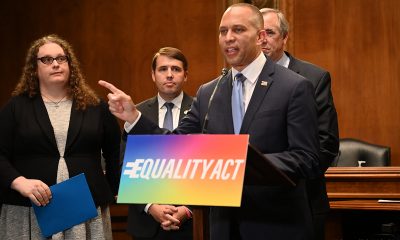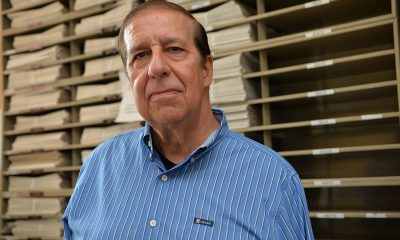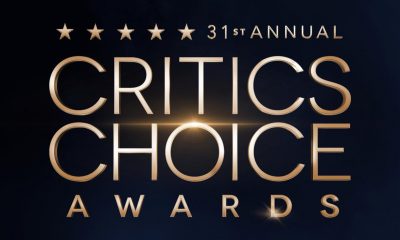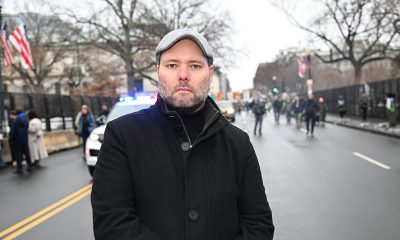a&e features
Festering frustration
Activists say police abuse is common link to gay, black riots
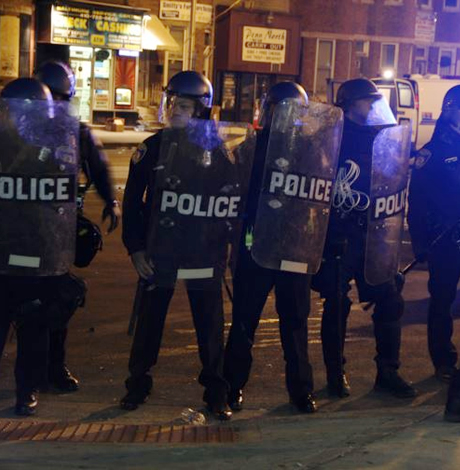
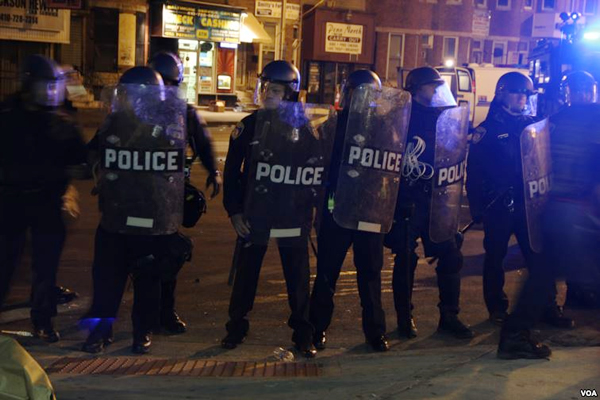
Some in the LGBT community questioned why Baltimore black youth would riot in their own neighborhoods, ignoring their own community’s history of rioting against police injustice. (Photo by Victoria Macchi/VOA News public domain)
The Stonewall riots triggered by a police raid on a New York City gay bar in 1969 and three other lesser known gay riots in San Francisco were reactions to police abuse and perceived societal oppression, according to LGBT activists familiar with those incidents.
San Francisco gay and AIDS activist Cleve Jones, who witnessed two of the gay riots in his city in 1979 and 1991, is among those who say there are similarities between the police abuse experienced by young gay men back in the 1960s and 1970s and young black men today.
Jones and other LGBT activists point to the incident involving 25-year-old African American Freddie Gray, whose death on April 19 from a severe spinal cord injury he sustained while in custody of Baltimore police triggered riots and looting.
Officials with several national LGBT rights groups, including the National Black Justice Coalition, have joined African-American civil rights leaders in denouncing the action by six Baltimore police officers who detained and arrested Gray on a charge of possessing a small knife that was later found to be legal to carry.
The groups said Gray’s death in a police-related incident, after officers reportedly ignored his pleas for medical treatment while being transported in a police wagon, highlighted similar instances of reported abuse by police against young black men in Baltimore and other parts of the country, including Ferguson, Mo.
“Where you can draw a parallel is with police relations,” Jones says. “I think to be a young gay person in San Francisco in the late 1970s, you would have many of the same kinds of feelings as young African Americans feel toward the police today.”
“When I got to San Francisco, the cops hated us. And they made it very, very clear every day,” Jones says. “I’m an old white man and unlikely to be singled out for my appearance for abuse by the police. But my memories of it from my youth are fresh.”
Jones was a student intern working for San Francisco Board of Supervisors member and gay rights advocate Harvey Milk in November 1978. It was at that time when Dan White, a disgruntled former police officer who had just resigned from his position as one of Milk’s fellow supervisors, shot Milk to death in Milk’s office at City Hall.
White killed Milk minutes after assassinating pro-gay San Francisco Mayor George Moscone in the mayor’s office in a fit of rage over Moscone’s refusal to reappoint White to his supervisor’s seat. White had announced he changed his mind and wanted to remain in office. Milk was among his fellow supervisors who urged Moscone not to reappoint White, who was part of a conservative faction on the Board of Supervisors that opposed Milk on many policy matters.
In May 1979, gays and other San Franciscans became outraged when a jury ignored prosecutors’ calls for convicting White on a first-degree murder charge and instead found him guilty of voluntary manslaughter, the most lenient possible charge for shooting two people to death.
Similar to the turn of events in Baltimore 36 years later, gays responded by holding a protest rally in the gay Castro neighborhood, which was Milk’s home base. They marched peacefully through the streets as the crowd swelled from about 500 to more than 1,500 people, according to news media accounts.
When the gathering of mostly LGBT people reached City Hall its ranks had increased to about 5,000, and violence broke out.
Police cars were set on fire, windows of nearby buildings were smashed and overhead wires for the city’s street cars were pulled down. Some of the rioters took tear gas canisters from damaged police cars and threw them at police, who initially stood on the sidelines at the direction of the police chief, again similar to the Baltimore disturbances this year, before the chief directed them to confront the rioters and force them away from the City Hall area.
About two-dozen arrests were made and more than 140 protesters and as many as 60 police officers were injured, news media reports said. The rioting caused hundreds of thousands of dollars in property damage to the City Hall building and nearby buildings and vehicles.
Jones, who was present when the rioting unfolded, said the longtime police hostility toward the gay community combined with the shock of a lenient jury verdict for the man who murdered Milk, a gay icon, prompted normally peaceful gays to embrace violence.
“I saw people who were known to be very well mannered who were completely consumed with rage and hatred of the police department,” he said. “It was a real desire to fight back, a sense that we had taken this kind of crap for far too long. … I think the LGBT people who were there that night — within all of us — the memories of prior abuses, the reality that we had been beaten up and called names and put down for so long — and then it was the last straw — that this all white, straight jury basically gave him a slap on the wrist.”
Compton’s Cafeteria Riot pre-dates Stonewall
New York’s Stonewall riots in Greenwich Village in 1969, where gays and transgender people fought back against a police raid, is considered the historic development that started the modern LGBT rights movement.
But three years earlier, in August 1966, a confrontation between a police officer and a person witnesses described as a drag queen inside Compton’s Cafeteria in San Francisco’s Tenderloin section erupted into what has become known as Compton’s Cafeteria Riot.
Transgender historian Susan Stryker, who co-wrote and co-directed a documentary film about the incident in 2005 called “Screaming Queens: The Riot at Compton’s Cafeteria,” is credited with helping piece together a comprehensive report on what happened.
LGBT activists are now calling the incident one of the first known transgender riots in U.S. history based on reports that Compton’s was a hangout for people who today would be considered transgender women.
Also patronizing Compton’s Cafeteria in the Tenderloin were the trans women’s gay male and lesbian friends. Nearly all of them, the documentary film says, were struggling to survive at a time when they were considered outcasts. Most lived in nearby cheap rooming houses and many engaged in prostitution. Most were also often harassed by the police at a time when cross dressing was against the law, Stryker reports in the documentary film.
According to the film, the riot started when a police officer threatened to arrest one of the male-to-female cross dressers inside Compton’s and she threw her coffee in his face. People interviewed in the film, which can be viewed on YouTube, said a melee then broke out among police and as many as 50 people inside the establishment, with windows shattered and dishes and furniture tossed around the room.
The fighting soon moved outside the restaurant, people in the film reported, creating a disturbance considered a full-fledged riot on the street.
“The violent oppression (and riot) of transgender people at Compton’s Cafeteria did not solve the problems that transgender people in the Tenderloin faced daily,” said transgender activist Autumn Sandeen in a 2010 article about the incident in gaylesbiantimes.com. “It did, however, create a space in which it became possible for the city of San Francisco to begin relating differently to its transgender citizens — to begin treating them, in fact, as citizens with legitimate needs instead of simply as a problem to get rid of.”
AB 1 Riots triggered by veto of gay rights bill
The fourth known gay riot in the United States took place in San Francisco on Sept. 30, 1991, after then-Republican Gov. Pete Wilson vetoed Assembly Bill 1, a gay rights measure that called for banning discrimination in employment, housing and public accommodations based on sexual orientation.
The bill had been stalled in committee for years before both houses of the legislature finally passed it in September 1991. Gay activists and their supporters in the legislature were outraged over Wilson’s veto, saying he acquiesced to the anti-gay faction of the state’s Republican Party.
“As was the case in the White Night riots, a large crowd assembled in the Castro and stormed the civic center,” says Jones, who was present as the crowd grew and became increasingly angry. “But instead of stopping at City Hall they went to the state building and did their best to set it on fire.”
A short documentary film on the AB 1 Riot, which included TV news footage of the incident, says about 2,000 protesters marched to the state building, where Wilson had an office. Protesters can be seen in the film using sections of metal barricade fences as battering rams to smash through the building’s glass doors.
The film also shows a protester using a large pole with a rainbow flag attached to it to smash through the glass doors on the building. It says the rioting caused over $250,000 in damage to the building, but no arrests were made and no serious injuries were reported.
‘Intersection’ between Baltimore and LGBT rights movement
Officials with some of the national LGBT groups talked about what they called the intersection between the Baltimore riots in late April of this year and the LGBT civil rights movement.
“The recent events in Baltimore and throughout the nation have been emotional, hurtful and even traumatic for so many in the black community,” says Sharon Lettman-Hicks, executive director and CEO of the National Black Justice Coalition, an LGBT civil rights organization.
“At the National Black Justice Coalition, we are dedicated to changing the mainstream narrative around socially marginalized black people, especially young people, because issues like police brutality and economic injustice are also LGBT issues that disproportionately impact LGBT people of color.”
“Black LGBT people cannot separate their blackness from their sexual orientation, gender expression or gender identity,” she says. “Issues that confront black people — like structural oppression, classism and racism in America — impact black LGBT people twofold.”
Mara Keisling, executive director of the National Center for Transgender Equality, says transgender people often face “brutal victimization, mistreatment and violence at the hands of law enforcement.”
She says NCTE works to address police abuse not only for transgender people but for everyone in its quest for “a more just society.”
According to Keisling, at least one transgender woman who was arrested during the Baltimore disturbances was placed in a men’s jail after police learned she was transgender. She was “forced to remove her undergarments and made to reveal her body to officers,” Keisling says.
“Our hearts go out to the family of Freddie Gray and to those people whose hearts are broken with grief,” says Rea Carey, executive director of the National LGBTQ Task Force. “Police-related killings of young black men have become a regular occurrence across our nation. So in a very real way what is happening in Baltimore is a predictable reaction to appalling injustice, deep mistrust of police and a real sense that nothing will be done about it.”
“The beauty and responsibility of the LGBT community is that we’re at the intersection of everything,” says Human Rights Campaign Vice President Fred Sainz. “We’re black, Asian, Latino and everything in between.
“Because of the stigma we face and the lack of legal protections, LGBT people are also more likely to face economic disenfranchisement,” he says. “What all of this means is that this must be a shared struggle and we also have a responsibility to make life better for all Americans.”
a&e features
Queer highlights of the 2026 Critics Choice Awards: Aunt Gladys, that ‘Heated Rivalry’ shoutout and more
Amy Madigan’s win in the supporting actress category puts her in serious contention to win the Oscar for ‘Weapons’

From Chelsea Handler shouting out Heated Rivalry in her opening monologue to Amy Madigan proving that horror performances can (and should) be taken seriously, the Critics Choice Awards provided plenty of iconic moments for queer movie fans to celebrate on the long road to Oscar night.
Handler kicked off the ceremony by recapping the biggest moments in pop culture last year, from Wicked: For Good to Sinners. She also made room to joke about the surprise hit TV sensation on everyone’s minds: “Shoutout to Heated Rivalry. Everyone loves it! Gay men love it, women love it, straight men who say they aren’t gay but work out at Equinox love it!”
The back-to-back wins for Jacob Elordi in Frankenstein and Amy Madigan in Weapons are notable, given the horror bias that awards voters typically have. Aunt Gladys instantly became a pop culture phenomenon within the LGBTQ+ community when Zach Cregger’s hit horror comedy released in August, but the thought that Madigan could be a serious awards contender for such a fun, out-there performance seemed improbable to most months ago. Now, considering the sheer amount of critics’ attention she’s received over the past month, there’s no denying she’s in the running for the Oscar.
“I really wasn’t expecting all of this because I thought people would like the movie, and I thought people would dig Gladys, but you love Gladys! I mean, it’s crazy,” Madigan said during her acceptance speech. “I get [sent] makeup tutorials and paintings. I even got one weird thing about how she’s a sex icon also, which I didn’t go too deep into that one.”
Over on the TV side, Rhea Seehorn won in the incredibly competitive best actress in a drama series category for her acclaimed performance as Carol in Pluribus, beating out the likes of Emmy winner Britt Lower for Severance, Carrie Coon for The White Lotus, and Bella Ramsey for The Last of Us. Pluribus, which was created by Breaking Bad’s showrunner Vince Gilligan, has been celebrated by audiences for its rich exploration of queer trauma and conversion therapy.
Jean Smart was Hack’s only win of the night, as Hannah Einbinder couldn’t repeat her Emmy victory in the supporting actress in a comedy series category against Janelle James, who nabbed a trophy for Abbott Elementary. Hacks lost the best comedy series award to The Studio, as it did at the Emmys in September. And in the limited series category, Erin Doherty repeated her Emmy success in supporting actress, joining in yet another Adolescence awards sweep.
As Oscar fans speculate on what these Critics Choice wins mean for future ceremonies, we have next week’s Golden Globes ceremony to look forward to on Jan. 11.
a&e features
Looking back at the 10 biggest A&E stories of 2025
‘Wicked,’ Lady Gaga’s new era, ‘Sexy’ Bailey and more

Although 2025 was a year marked by countless attacks on trans rights and political setbacks, the year also saw brilliant queer artists continuing to create art. From Cannes and Sundance Award winners now vying for Oscar consideration to pop icons entering new stages of their careers, queer people persevered to tell their stories through different media.
With the state of the world so uncertain, perhaps there’s no more vital time to celebrate our wins, as seen through some of this year’s top pop culture moments. While there’s no collection of 10 stories that fully encompass “the most important” news, here are some events that got the gays going:
10. ‘Mysterious Gaze of the Flamingo’ wins big at Cannes

The Cannes Film Festival has become a crucial start for films hoping to make their way to the Oscars, and first-time director Diego Céspedes won the top Un Certain Regard prize for his intimate western “The Mysterious Gaze of the Flamingo.” The film is set in the ‘80s and is intended as an allegory for the AIDS epidemic. Seeing a film that unpacks vital queer history win one of the most coveted awards at Cannes has been a huge point of pride in the independent filmmaking community.
Since the film bowed at Cannes, it has been selected as Chile’s Oscar entry in the Best International Feature race. Speaking with The Blade during the film’s AFI Fest run in October, Céspedes said: At first, I was kind of scared to have this campaign position in the times that we’re living [in] here. But at the same time, I think the Oscars mean a huge platform — a huge platform for art and politics.”
9. ‘The Last of Us’ returns for an even gayer season 2
While the first season of The Last of Us gave us one of TV’s most heartbreaking queer love stories in the episode “Long, Long Time,” Season 2 doubled down on its commitment to queer storytelling with the blossoming relationship between Ellie (Bella Ramsey) and Dina (Isabela Merced). The show expanded on the pair’s relationship in the original video game, making it perhaps the central dynamic to the entire season. That unfortunately came with more homophobic backlash on the internet, but those who checked out all the episodes saw a tender relationship form amid the show’s post-apocalyptic, often violent backdrop. For their performance, Ramsey was once again nominated for an Emmy, but Merced deserved just as much awards attention.
8. ‘Emilia Pérez’ sparks controversy
Jacques Audiard’s genre-bending trans musical “Emilia Pérez” proved to be an awards season juggernaut this time last year, winning the Golden Globe for Best Musical/Comedy. But when the lead star Karla Sofia Gascón’s racist, sexist, and homophobic old tweets resurfaced, the film’s Oscar campaign became a tough sell, especially after Netflix had tried so hard to sell Emilia Pérez as the “progressive” film to vote for. Mind you, the film had already received significant backlash from LGBTQ+ audiences and the Mexican community for its stereotypical and reductive portrayals, but the Gascón controversy made what was originally just social media backlash impossible to ignore. The only person who seemed to come out of the whole debacle unscathed was Zoe Saldaña, who won the Oscar for Best Supporting Actress over Ariana Grande.
7. ‘Sorry, Baby’ establishes Eva Victor as major talent
Back in January at the Sundance Film Festival, Eva Victor (known by many for her brand of sketch comedy) premiered their directorial debut “Sorry, Baby” to rave reviews, even winning the Waldo Salt Screening Award. Victor shadowed Jane Schoenbrun on the set of “I Saw the TV Glow,” and seeing Victor come into their own and establish such a strong voice immediately made them one of independent cinema’s most exciting new voices. A memorable scene in the film sees the main character, Agnes (played by Victor), struggling to check a box for male or female, just one example of how naturally queerness is woven into the fabric of the story.
Most recently, Victor was nominated for a Golden Globe for her performance in the film, and she’s represented in a category alongside Jennifer Lawrence (“Die My Love”), Jessie Buckley (“Hamnet”), Julia Roberts (“After the Hunt”), Renate Reinsve (“Sentimental Value”) and Tessa Thompson (“Hedda”). The film also received four Independent Spirit Award nominations overall.
6. Paul Reubens comes out in posthumous doc

While Paul Reubens never publicly came out as gay before passing away in 2023, the two-part documentary “Pee-wee as Himself” premiered back in May on HBO Max, giving the legendary comedian a chance to posthumously open up to the world. Directed by Matt Wolf, the documentary explores how Reubens found his alter ego Pee-Wee Herman and why he kept his private life private.
The documentary won an Emmy in the Outstanding Documentary or Nonfiction Special category and remains one of the most critically acclaimed titles of the year with a 100% Rotten Tomatoes score. Also worth noting, the National Geographic documentary Sally told the posthumous coming out story of Sally Ride through the help of her long-time partner, Tam O’Shaughnessy.
5. Lady Gaga releases ‘Mayhem’
Lady Gaga entered a new phase of her musical career with the release of Mayhem, her seventh album to date. From the frenzy-inducing pop hit Abracadabra to the memorable Bruno Mars duet featured on “Die With a Smile,” seeing Gaga return to her roots and make an album for the most die-hard of fans was especially rewarding after the underwhelming film releases of “House of Gucci” and “Joker: Folie à Deux.” Gaga has been touring with The Mayhem Ball since July, her first arena tour since 2018. She even extended her tour into 2026 with more North American dates, so the party isn’t stopping anytime soon. And Gaga is even set to make an appearance next May in “The Devil Wears Prada 2.”
4. Cynthia Erivo, Ariana Grande perform at the Oscars

While “Wicked: For Good” didn’t quite reach the heights of the first film, we will forever have Cynthia Erivo and Ariana Grande’s breathtaking live performance that opened the 97th Academy Awards. The pair sang a rendition of “Over the Rainbow,” “Home,” and “Defying Gravity,” paying proper homage to the original 1939 “Wizard of Oz.” Even non-Wicked fans can’t deny how magical and brilliantly staged this performance was. With both Erivo and Grande up for acting Oscars last year, they’re hoping to repeat success and make history with consecutive nominations. Either way, let’s hope there’s another live performance in the making, especially with two new original songs (The Girl in the Bubble and No Place Like Home) in the mix.
3. Indya Moore speaks out against Ryan Murphy
Indya Moore has consistently used social media as a platform for activism, and in September, posted a 30-minute Instagram live speaking out against “Pose” co-creator Ryan Murphy. Moore claimed that Murphy wasn’t being a true activist for trans people. “Ryan Murphy, we need you to do more. You need to address the racism, the violence, and the targeting of people on your productions, Ryan Murphy. You do need to make sure trans people are paid equally. Yes, Janet did the right thing,” Moore said. Murphy was also back in the headlines this year for the critically panned “All’s Fair” and the controversial “Monster: The Ed Gein Story” starring Laurie Metcalf and Charlie Hunnam.
2. Cole Escola wins Tony for Best Leading Actor
Few pop culture moments this year brought us together more than Cole Escola winning a Tony award for “Oh, Mary!” the Broadway show they created, wrote and starred in (we love a triple threat!) Escola made history by becoming the first nonbinary person to win a Tony in the leading actor category, and seeing them excitedly rush to the stage wearing a Bernadette Peters-inspired gown instantly became a viral social media moment.
The cherry on top of Escola’s major moment is the recent news that they are writing a Miss Piggy movie with Jennifer Lawrence and Emma Stone producing — news that also broke the internet for the better. We cannot wait!
1. Jonathan Bailey makes gay history as ‘Sexiest Man Alive’

The same year as his on-screen roles in blockbusters “Jurassic World Rebirth” and “Wicked: For Good,” Jonathan Bailey made history as the first openly gay man to be named People magazine’s “Sexiest Man Alive.” The fact that it took 40 years for an openly gay man to earn the title is a signifier of how far we still have to go with queer representation, and seeing Bailey celebrated is just one small step in the right direction.
“There’s so many people that want to do brilliant stuff who feel like they can’t,” he told PEOPLE, “and I know the LGBT sector is under immense threat at the moment. So it’s been amazing to meet people who have the expertise and see potential that I could have only dreamed of.” In 2024, Bailey founded the charity titled The Shameless Fund, which raises money for LGBTQ+ organizations.
a&e features
Your guide to D.C.’s queer New Year’s Eve parties
Ring in 2026 with drag, leather, Champagne, and more
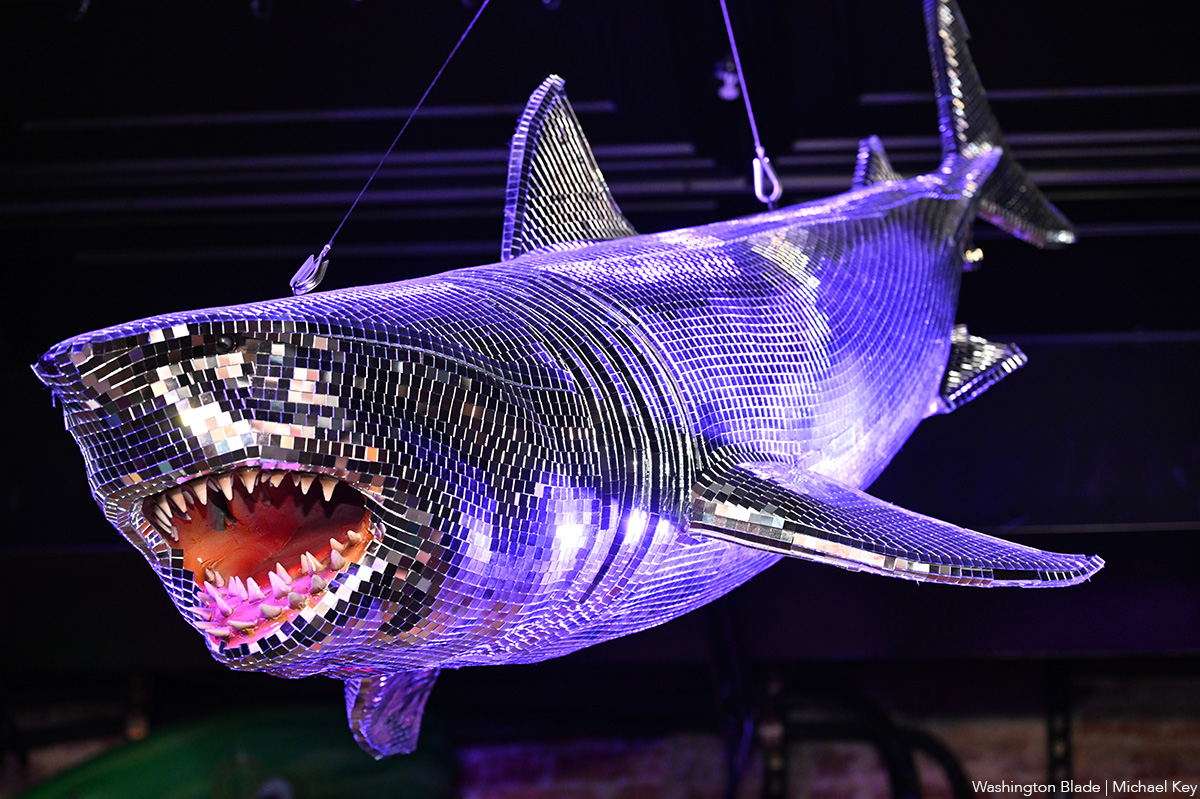
With Christmas in the rear view mirror, we can turn our attention to ringing in a much-anticipated New Year with a slew of local LGBTQ parties. Here’s what’s on tap.
Pitchers
This spacious Adams Morgan bar is hosting the “Pitchers’ Perfect New Year’s Eve.” There will be a midnight Champagne toast, the ball drop on the big screens, and no cover, all night long. The bar doesn’t close until 4 a.m., and the kitchen will be open late (though not until close). All five floors will be open for the party, and party favors are promised.
Trade
D.C.’s hottest bar/club combo is leaning into the Shark motif with its NYE party, “Feeding Frenzy.” The party is a “glitterati-infused Naughty-cal New Year’s Even in the Shark Tank, where the boats are churning and the sharks are circling.” Trade also boasts no cover charge, with doors opening at 5 p.m. and the aforementioned Shark Tank opening at 9 p.m.. Four DJs will be spread across the two spaces; midnight hostess is played by Vagenesis and the two sea sirens sensuously calling are Anathema and Justin Williams.
Number Nine
While Trade will have two DJs as part of one party, Number Nine will host two separate parties, one on each floor. The first floor is classic Number Nine, a more casual-style event with the countdown on TVs and a Champagne midnight toast. There will be no cover and doors open at 5 p.m. Upstairs will be hosted by Capital Sapphics for its second annual NYE gathering. Tickets (about $50) include a midnight Champagne toast, curated drink menu, sapphic DJ set by Rijak, and tarot readings by Yooji.
Crush
Crush will kick off NYE with a free drag bingo at 8 p.m. for the early birds. Post-bingo, there will be a cover for the rest of the evening, featuring two DJs. The cover ($20 limited pre-sale that includes line skip until 11 p.m.; $25 at the door after 9 p.m.) includes one free N/A or Crush, a Champagne toast, and party favors (“the legal kind”). More details on Eventbrite.
Bunker
This subterranean lair is hosting a NYE party entitled “Frosted & Fur: Aspen After Dark New Year’s Eve Celebration.” Arriety from Rupaul Season 15 is set to host, with International DJ Alex Lo. Doors open at 9 p.m. and close at 3 p.m.; there is a midnight Champagne toast. Cover is $25, plus an optional $99 all-you-can-drink package.
District Eagle
This leather-focused bar is hosting “Bulge” for its NYE party. Each District Eagle floor will have its own music and vibe. Doors run from 7 p.m.-3 a.m. and cover is $15. There will be a Champagne toast at midnight, as well as drink specials during the event.
Kiki, Shakiki
Kiki and its new sister bar program Shakiki (in the old Shakers space) will have the same type of party on New Year’s Eve. Both bars open their doors at 5 p.m. and stay open until closing time. Both will offer a Champagne toast at midnight. At Kiki, DJ Vodkatrina will play; at Shakiki, it’ll be DJ Alex Love. Kiki keeps the party going on New Year’s Day, opening at 2 p.m., to celebrate Kiki’s fourth anniversary. There will be a drag show at 6 p.m. and an early 2000s dance party 4-8 p.m.
Spark
This bar and its new menu of alcoholic and twin N/A drinks will host a NYE party with music by DJ Emerald Fox. Given this menu, there will be a complimentary toast at midnight, guests can choose either sparkling wine with or without alcohol. No cover, but Spark is also offering optional wristbands at the door for $35 open bar 11 p.m.-1 a.m. (mid-shelf liquor & all NA drinks).
-

 Sponsored4 days ago
Sponsored4 days agoSafer Ways to Pay for Online Performances and Queer Events
-

 District of Columbia4 days ago
District of Columbia4 days agoTwo pioneering gay journalists to speak at Thursday event
-

 a&e features4 days ago
a&e features4 days agoQueer highlights of the 2026 Critics Choice Awards: Aunt Gladys, that ‘Heated Rivalry’ shoutout and more
-

 Colombia3 days ago
Colombia3 days agoBlade travels to Colombia after U.S. forces seize Maduro in Venezuela





